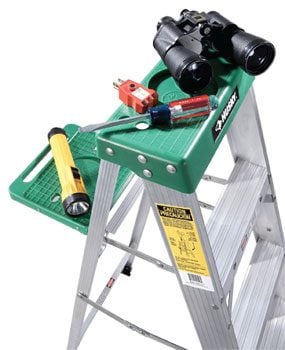DIY Home Inspection Tools
Assemble a Few Basic Tools
When shopping for a new home, be sure to check over any likely candidate before making an offer. You’ll then avoid major, expensive “surprises” after you move in. In this article, we’ll help you identify warning signs so you can plan for repairs, adjust your offering price, or simply eliminate certain homes from consideration. Once you find a house or two that you’re definitely interested in, go back to them with the tools and tips shown here. And if you’re still interested, hire a professional inspector to more thoroughly examine the house.
Visually Examine Walls and Ceilings
Start by looking for discoloration on the walls and ceilings. Yellow spots indicate water damage. Large ones on the ceiling point to a leaky roof, or if they’re next to exterior walls, ice dams. Small water spots are probably leaking or sweating plumbing pipes—and can represent major hidden damage.
Black spots on the walls are usually evidence of mold. While mold can be treated and isn’t a reason to panic, the cause of the mold, excess moisture, can be difficult to fix. If the mold is in a bathroom, better ventilation may be the answer, but if it’s in the basement, the fix is usually much harder. If you spot basement mold, also look for efflorescence (powdery white deposits) along the foundation walls and concrete slab that result from water seepage. Spalling (corrosion) on concrete blocks in the crawl space or basement is another telltale sign of moisture coming in through the walls. So are bowed walls. In crawl spaces, look for mold and rotting wood on floor joists. A musty smell is also indicative of moisture problems.
Assess the Plumbing
To check for problems with water pressure and drain venting, turn on the water in the bathroom sink or tub, then flush the toilet. Look for a noticeable drop in water pressure and listen for gurgling noises in the pipes. Run water in each sink for two to three minutes to make sure the water drains nearly well enough to keep up with the flow. Also check the drainpipes in bathroom vanities and under the kitchen sink. Make sure each pipe goes into the wall. If it heads straight into the floor, that probably means the drain isn’t vented (and adding a vent is a big job, usually requiring a plumber).
Examine the Windows and Furnace
Examine the windows. Fogged windows will need to be replaced (and that’s not cheap!). Excessive condensation on the windows may be the result of a failed heat exchanger or an ailing furnace (although it could be other factors too). Unfortunately, humidity and temperature conditions might make condensation hard to spot, especially during the warm seasons. Still, check the age of the furnace and look for stickers that document routine service. Expect a well-maintained furnace to last 30 to 40 years. Otherwise, a 20- to 25-year life span is typical.
Check Electrical Outlets and Switches
Check a few electrical outlets with your receptacle tester to ensure they’re wired correctly. Brand new outlets sometimes mean the room was recently wired. Problems like reverse polarity suggest the work was done by the homeowner and not inspected.
Inspect the Exterior
Look at the shingles through binoculars. Age is not the best indicator of potential problems (some asphalt shingles last more than 30 years; some don’t last 10). Cupping, curling, cracking and rounded edges mean the shingles need to be replaced. While you’re outside, probe the deck and structural boards, especially near the ends where rot starts. Make sure the posts aren’t dislocated by frost heave and the beams and joists are in good shape. Look for flashing around the ledger board.
Finally, ask about the age of the septic tank (it may not be the same age as the house). If the tank is over 30 years old, it may be nearing the end of its life span.
But don’t trust your own inspection to be the final word. Hire a professional home inspector before putting down money. The $300 to $500 it’ll cost is well worth it.
Required Tools for this Project
Have the necessary tools for this DIY project lined up before you start—you’ll save time and frustration. [project-tools] You’ll also need a receptacle tester and binoculars.

No comments